7 Steps to create a PPE Program that Really Works

Designing a PPE Program To Ensure Safety At Work
The purpose of a PPE program is to protect your employees by ensuring that Personal Protective Equipment (PPE) is provided, used, and maintained in a reliable condition whenever it is necessary due to hazards from processes or in the work environment.
In the initial stages of designing your PPE Program, make sure that all steps have been made in the identification, elimination, substitution, engineering and administrative controls of workplace hazards.
1. Select a PPE organiser
This person will be a central source and should be responsible for assessing the hazards and exposures that may require the use of PPE, determining the type of equipment to be provided, and purchasing the equipment. They will also be responsible for gathering information from management, supervisors, and employees with regard to the selection of PPE as well as enforcing the program at all levels. The success of the PPE program depends upon the cooperation and support of all those concerned.
2. Identify workplace hazards and Perform a risk assessment
◉ Review work practices, job procedures, equipment, and plant layout.
◉ Use job hazard analysis techniques to integrate accepted safety and health principles and practice into specific operations.
3. Selecting the right PPE for the task
◉ Select the PPE to match the hazard you’re your industry standards.
◉ Get expert advice on the best products to meet your requirements.
◉ Trial the products with the team members who will be using it.
◉ Ensure the physical comfort of the PPE. (If it’s not comfortable there is a chance it will get misused or not used at all).
◉ Evaluate cost considerations of PPE usage and look at the ROI.
◉ Ensure PPE meets all industry standards/certifications.
◉ Fit PPE to each individual.
4. Designing internal communications strategy
Design your internal communications strategy and identify ambassadors at every level of the business who will be responsible for the dissemination of information.
5. Total commitment to the program
Demonstrate total commitment to the program and ensure that a clear concise policy is agreed upon and posted in public areas. Make safety and PPE part of your workplace culture, applying as much to visitors or admin staff popping onto the shop floor as it does for full-time machine operators.
6. Choosing supervisors
Choose Supervisors or senior team members who can be charged with grassroots implementation of training, maintenance, and inspection. These people should be easily identified.
It is the responsibility of each supervisor to ensure that the correct PPE is worn and to check with your PPE organiser if there are any doubts. It is also the responsibility of each identified supervisor to ensure that all team members perform the required maintenance and inspections of the PPE.
◉ Inspect PPE before and after each use.
◉ Take care of PPE at all times.
◉ Clean all PPE after use.
◉ Repair or replace damaged or broken PPE.
◉ Store PPE in clean, dry air - free from exposure to sunlight or contaminants.
7. Education and Training
◉ Participate in education and training in how to fit, wear, and maintain PPE.
◉ Consider introducing eLearning for Safety and Compliance so training or retraining can be completed quickly and effectively to people at different learning levels.
◉ Ask questions to make sure everyone knows when and what PPE should be worn, and why it should be worn.
◉ Ensure that clear signage appears at all workstations where hazardous tasks are completed.
8. Audits and Surveys
◉ Review the program every 6-12 months.
◉ Review and compare production and safety performance records.
◉ Survey users of the PPE to ensure that products are still fulfilling the requirements.
◉ Make results available to everyone within the company.
CONTACT US
If you think your company or business would benefit from a new PPE program, please contact your State Sales Manager to set up a meeting today! Call us on 07 3265 2944 or visit message us through our Contact Page.








